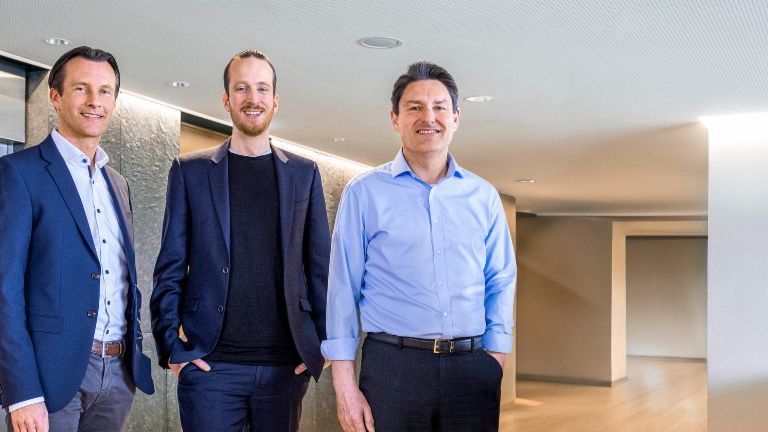Digitalization as an opportunity.
EOS has been on the digital transformation path for years now. In this article, Jürgen Borgartz, Managing Director of EOS Deutschland, describes the added value and the opportunities for companies that arise out of this.
- Digitalization of debt collection processes leads to a win-win-win situation for all participants – defaulting customers, clients, and debt collection service providers.
- The digital transformation starts with the employees and requires that they be willing to take this path.
At first glance, the title “Digitalization as an opportunity” seems as trivial as it is all-encompassing. Digitalization is no longer a major challenge for people today. Instead, it is a means to an end, offers support and assistance in everyday life, and makes many aspects of life more convenient. Digitalization is increasingly being expected of corporations, authorities, and service providers. My cell phone is not just my phone, but my life: I communicate via all channels with my smartphone, organize my everyday life and my personal environment with it, manage my finances and insurance with it, and use it for accessing knowledge and, completely incidentally, for my own entertainment, which takes up the most time overall.
Digitalization above all means “creating added value”.
But what does digitalization mean generally and specifically for the NPL market, or our industry? Generally speaking, digitalization does not mean takeover of the old world by technology. However, it does mean merging and development of functional and technical contents that contribute to the added value of the business purpose and thus of the company. So, to put it simply, digitalization for me means creating added value. In the area of NPL processing, digitalization doesn’t just lead to reduction of costs, avoidance of careless mistakes arising because of boring, repetitive tasks in receivables processing, and extension of touchpoints for defaulting customers. Experience shows that it’s more.
I would like to begin with my understanding of digitalization in the context of debt collection. Digitalizing debt collection means sustainably employing every useful technical development within the framework of the legal possibilities from the point of view of debt collection – for the benefit of the defaulting customers, the clients, and the debt collection service provider. This creates a win-win-win situation for everyone involved, which leads to lower costs and fewer mistakes, accelerated processes, and greater convenience and ultimately enables optimal repayment of total debt.
Dismantling of legacy is the prerequisite for fast further development.
This, in turn, means more than just an opportunity from a cost perspective. Digitalization is a path and, for me, it begins with legacy dismantling. My colleague Tim Weickert, Managing Director of EOS Technology Solutions GmbH, provides a description for this: “It’s about creating the technical conditions for rapid further development. Legacy – or technical debt – already exists when a new system is used for the first time.
Technical debt increases linearly over time, but the rate of further development decreases exponentially with technical debt. It’s not noticeable in the beginning; however, at some point, further development approaches zero because you’re only servicing the technical debt. For this reason, it’s important to allow and demand time for legacy removal right from the start and on a regular basis.”
In addition, there is not only technology-related legacy. We humans are also partly legacy, in the context of inheritance here, especially when it comes to the topic of digitalization. Digitalization affects everything we have learned up to now and challenges us humans to break out of our established patterns of behavior. As soon as we have understood that, digitalization is an opportunity for us. If employees refuse to accept the changes, digitalization will fail not because of the technology, but ultimately because of the people.

Employees are drivers of the digital transformation.
In reality, this path means work, especially against your own fear. Additionally, there must be a fundamental willingness to be enthusiastic about new things, to see opportunities in them, and, at the same time, to deviate from approaches that have been quite successful up to now. I can say that I have been successfully working in the industry as a leader and manager for 30 years now and have therefore historically been strongly influenced by a self-image of command and control in my management style. I can openly and self-critically state that companies with this approach today neither gain or retain motivated employees nor bring innovations to entrenched structures.
As soon as you have recognized this, you can start with the implementation – both with yourself and with your colleagues. This is not easy and needs time. Nevertheless, I am convinced that this work is worthwhile in all areas. However, this also requires that all employees understand the opportunity of digitalization consistently across hierarchies and functions and additionally are willing to live this path. It starts with each individual, and without a fundamental willingness to change on the part of people, digitalization will fail. This realization forms the foundation for the actual benefit and thus the opportunity of digitalization. Only with the updating of technology and the willingness of the employees can a company change to digitalization take place because only then will a change take place in the corporate culture.
I am no expert in corporate culture and I will spare you theories, but I would still like to relate a story from practice – more specifically, from the last six years in which the company in which I work experienced exciting and good as well as painful times. This period was mainly marked by a struggle between a corporate culture of command and control developed over time and a new world with working methods that not only appeared to go against all reason at the beginning but also brought deep conflict to the experienced and Hanseatic businessman’s heart. Since then, the goal has been to exchange control for trust and knowledge monopolies for organized knowledge management, to make managers coaches for employees, and to develop the teams so as to transform them from instruction receivers to autonomous entrepreneurs who participate in discussions, get involved, and advance topics independently. Decisions have been and will continue to be made not by managers with superficial, general knowledge, but by multidisciplinary teams that enrich one another with know-how to make joint decisions. I am well aware that the world is not just black and white because in the past, too, there have been autonomous employees and this world also functioned quite well. For me, there are currently still numerous gray areas in which the mix of old and new worlds creates the greatest added value.

Ultimately, however, the new world and increased reliance on personal responsibility and entrepreneurial thinking in the workforce are the basis for a digital future.
Responsibility is what drives your own success.
To understand the impact on the corporate culture, it helps to take an excursion into the agile world and examine the effect on cross-functional cooperation, structures, and hierarchies. Here, too, I can support my message with the experience of my colleague Tim Weickert, who describes it as follows: “In the agile context, successful teams have many things in common. First and foremost is the security of being able to articulate an opinion and being allowed to take and defend a position independently of the hierarchy. People in the past often agreed with the HiPPO (highest paid person’s opinion) in the room. This did not always lead to the best solutions. Another thing is the personal feeling of (professional) security in the change. If you perceive changes as security, you think in terms of opportunities and no longer in terms of problems. The responsibility of people and/or teams is another aspect. If a team assumes responsibility, then it stands by it – in failure and in success. Successful teams assume responsibility; it is what drives their success. Finally, successful teams need direction. It’s no longer about extensive requirements specifications or design specifications with the final product description. The path is characterized by small steps that are based on the benefit to the customer. The final result is similar to the vision, but in the iterative process, a successful team will always implement the best solution for the customers, never just what the marketing department or management wants.”
As far as this impact is understood as being an opportunity, there are two consequences for the company, namely, an active and a reactive one. The active consequence can be introduced with the following question: Which conditions can and must I as the manager proactively create so that digitalization can unfold to the greatest extent? This deliberation concerns all areas of the company. An example and immediately obvious is the question of the structure. Which organizational structure is suitable for a digital environment as described above? How pronounced does the hierarchy (organizations like to think in terms of organizational charts) still have to be and what understanding of leadership is needed by this culture? Which people do I need and which ones do I have? How can I actively accompany them into the new world? How do I find new employees that contribute to it and is my recruiting process adapted to it? Which infrastructure requires this type of work and what effects do these working methods have on my regular corporate planning culture?
Experience shows that a lot can be preconceived and prepared, but it is important to be aware of the second consequence: What is right and wrong has to develop without guidelines with fewer “thought-through” preconditions and more focus on the understanding and personal responsibility of the employees. In other words, you simply have to take the time to ensure that the majority of the people involved intrinsically recognize which prerequisites are required, or what each person can do to move the company forward.
It is a fine line that corporate management must walk between letting go and providing sufficient room for ensuring the profitability and further development of the company. In reality, my experience has shown that you have to intervene less actively when certain prerequisites are in place, when you act boldly and consistently, and when there are enough digital thinkers and influencers in the company. This allows you to grant employees creative freedom. As a manager, you can then, in the best case, provide reactive support and intervene with coordinative measures when necessary. However, no company develops perfectly and that’s why a corrective intervention is also sometimes required.
Digitalization makes room for independent thinking and innovations.
But what does that lead to and what does it have to do with “digitalization as an opportunity”? This path leads to innovation and the continuous creation of added value in all dimensions of a company. One of the greatest added values of digitalization is the time gained and the elimination of monotonous and repetitive activities and processes. Time is thus created for useful things and this, in turn, is equivalent to fun and complex actions; there is room for independent thinking and innovations. For me, it also means creating certain basic conditions in which the best free spirits want to work and the greatest reward for them is the visible added value that they generate.
Thus I come to my conclusion: Everything that can be digitalized will be digitalized at some point. To be successful over the long term, a company has to focus its sights on this or disappear into the abyss. Digitalization is more than an opportunity. Lived, it is a motor for the development of employees, working methods, and thus the corporate culture. As a consequence, digitalization is not just an opportunity, but it is absolutely necessary for maintaining the competitiveness of any company. This applies to all industries and also the NPL sector because through digitalization, we create added value: for defaulting customers, clients, and us as service providers.
Photo credits: EOS
Explore more from EOS



